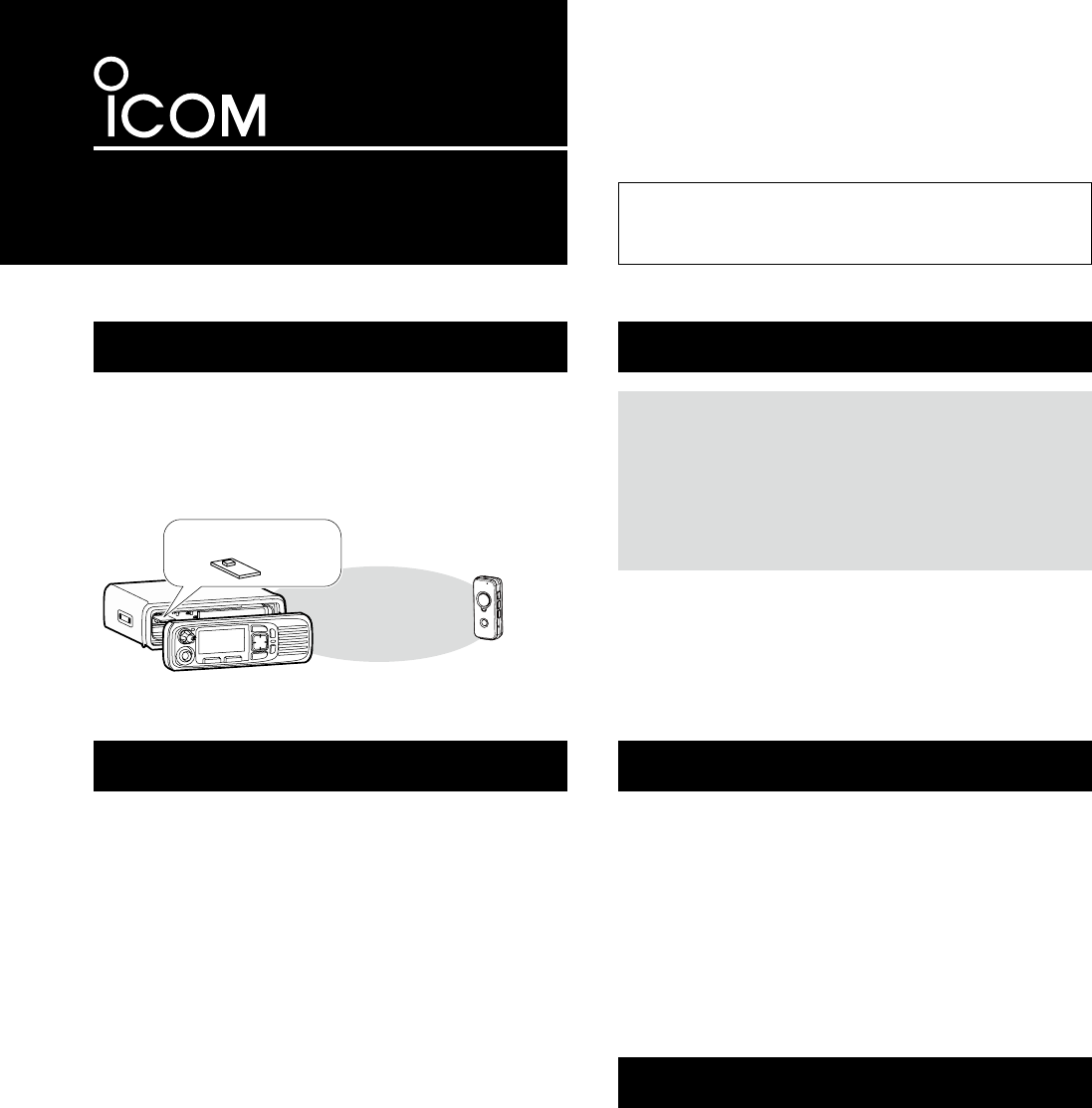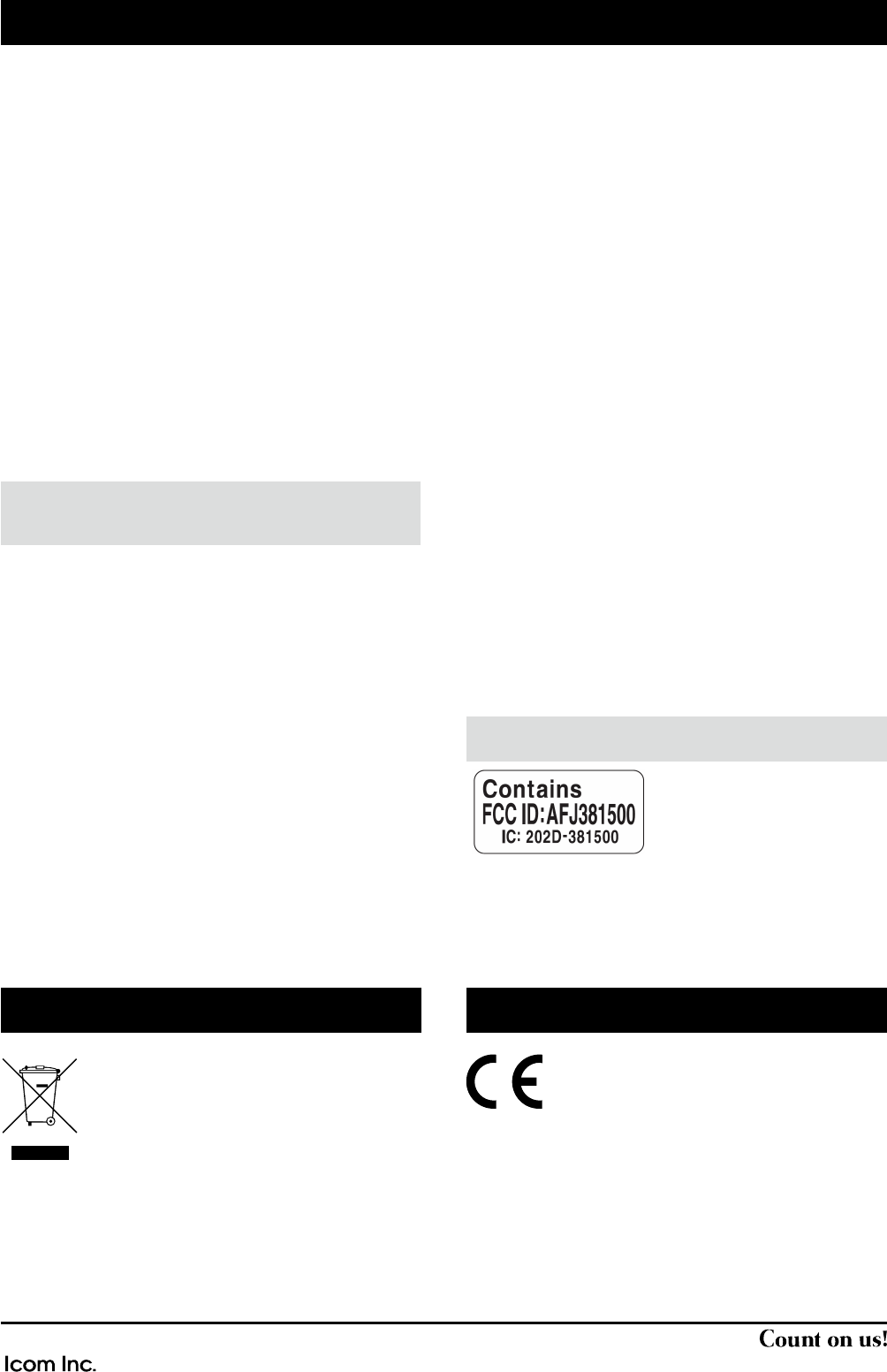ICOM orporated 381500 Bluetooth Unit User Manual
ICOM Incorporated Bluetooth Unit
User Manual

INSTRUCTIONS
Bluetooth® UNIT
UT-136
Thank you for choosing this Icom product.
READ ALL INSTRUCTIONS carefully and completely
before using this product.
Icom, Icom Inc. and the Icom logo are registered trademarks of
Icom Incorporated (Japan) in Japan, the United States, the United
Kingdom, Germany, France, Spain, Russia, Australia, New Zealand
and/or other countries.
The Bluetooth® work mark and logos are registered trademarks
owned by Bluetooth SIG, Inc. and any use of such marks by Icom
inc. is under license.
All other products or brands are registered trademarks or
trademarks of their respective holders.
About the UT-136
The UT-136 is a Bluetooth
®
unit to be installed in a
transceiver to communicate with other Bluetooth
®
devices.
Please refer to the transceiver’s instruction manual or ask
dealer for details regarding installation and use of the
Bluetooth
®
unit with the transceiver.
Precautions
When you use a Bluetooth
®
device, pay attention to
following:
Bluetooth
®
devices operate on the 2.4 GHz band.
The 2.4 GHz band is also used by other devices, such as
wireless LAN products, microwave ovens, RFID systems,
amateur radio stations, and so on.
When using a transceiver with the Bluetooth
®
unit installed
and turned ON near such devices, interference may occur,
causing a decrease in communication speed, and an
unstable connection.
In such cases, use the transceiver with the Bluetooth
®
unit
away from the other devices, or stop using those devices.
Electromagnetic Interference
The Bluetooth
®
communication range may vary,
depending on the environment in which the device
operates. Microwave ovens or wireless LAN may cause an
interference.
In that case, stop using those devices or move away the
Bluetooth
®
device from the other devices.
This Bluetooth® device has a range of use. If the
communication is unstable, use the device within the range.
Radio operator warnings
• Do not use a transceiver with the Bluetooth
®
unit installed
and turned ON near medical equipment, or near a person
who has a pacemaker. Radio waves from the transceiver
may cause interference, or endanger their life.
• Do not use a transceiver with the Bluetooth
®
unit installed
and turned ON near microwave ovens. Interference may
occur.
• Do not make any changes or modifications to the unit.
DO NOT put anything on top of the unit, before installing.
DO NOT drop, impact or vibrate the unit, before installing.
This may damage to the unit.
You may not be able to use some Bluetooth
®
device’s
function, even if the unit is installed.
Specifications
• Bluetooth
®
version: Bluetooth
®
Version 3.0
• Transmission Output: Class 1
• Supported profiles: HFP, HSP, SPP
• The maximum number of paired Bluetooth
®
devices:
8 devices*
* You can pair with up to 8 headsets and
data devices. The 8 paired devices
cannot be all headsets or all data
devices.
• Dimensions: 18.0 (W) x 34.0 (H) x 2.2 (D) mm
(0.71 (W) x 1.34 (H) x 0.09 (D) inch)
• Weight (approximate): 1.45 g (0.05 oz)
• Device Name: Icom BT-001 (default value)
• Passkey: 0000 (four zeros)
The specifications are subject to change without notice or
obligations.
Bluetooth® unit
Transceiver VS-3
Bluetooth®

A-7318?-1EX
© 2016 Icom Inc.
1-1-32 Kamiminami, Hirano-ku, Osaka 547-0003, Japan
FCC and IC information
• FOR CLASS B UNINTENTIONAL RADIATORS:
This equipment has been tested and found to comply with
the limits for a Class B digital device, pursuant to part 15 of
the FCC Rules. These limits are designed to provide reason-
able protection against harmful interference in a residential
installation. This equipment generates, uses and can radiate
radio frequency energy and, if not installed and used in ac-
cordance with the instructions, may cause harmful interfer-
ence to radio communications. However, there is no guaran-
tee that interference will not occur in a particular installation.
If this equipment does cause harmful interference to radio or
television reception, which can be determined by turning the
equipment off and on, the user is encouraged to try to correct
the interference by one or more of the following measures:
• Reorient or relocate the receiving antenna.
• Increase the separation between the equipment and re-
ceiver.
• Connect the equipment into an outlet on a circuit differ-
ent from that to which the receiver is connected.
• Consult the dealer or an experienced radio/TV techni-
cian for help.
CAUTION: Changes or modifications to this device, not
expressly approved by Icom Inc., could void your authority
to operate this device under FCC regulations.
This device complies with Part 15 of FCC and Industry Can-
ada licence-exempt RSS standard(s). Operation is subject to
the following two conditions: (1) this device may not cause in-
terference, and (2) this device must accept any interference,
including interference that may cause undesired operation
of the device.
This transmitter must not be co-located or operated in con-
junction with any other antenna or transmitter.
CAN ICES-3 (B)
Le présent appareil est conforme aux la partie 15 des règles
de la FCC et CNR d'Industrie Canada applicables aux ap-
pareils radio exempts de licence. L'exploitation est autori-
sée aux deux conditions suivantes: (1) l'appareil ne doit pas
produire de brouillage, et (2) l'utilisateur de l'appareil doit ac-
cepter tout brouillage radioélectrique subi, même si le brouil-
lage est susceptible d'en compromettre le fonctionnement.
Cet émetteur ne doit pas être co-localisé ou fonctionner en
conjonction avec une autre antenne ou émetteur.
NMB-3 (B)
• For Mobile Use
This equipment complies with FCC/IC radiation exposure
limits set forth for an uncontrolled environment and meets
the FCC radio frequency (RF) Exposure Guidelines and
RSS-102 of the IC radio frequency (RF) Exposure rules. This
equipment has very low levels of RF energy that it deemed
to comply without maximum permissive exposure evaluation
(MPE).
Cet équipement est conforme aux limites d’exposition aux
rayonnements énoncées pour un environnement non con-
trôlé et respecte les règles les radioélectriques (RF) de
la FCC lignes directrices d’exposition et d’exposition aux
fréquences radioélectriques (RF) CNR-102 de l’IC. Cet équi-
pement émet une énergie RF très faible qui est considérée
conforme sans évaluation de l’exposition maximale autori-
sée.
• For Portable Use
This equipment complies with FCC/IC radiation exposure
limits set forth for an uncontrolled environment and meets
the FCC radio frequency (RF) Exposure Guidelines and
RSS-102 of the IC radio frequency (RF) Exposure rules. This
equipment has very low levels of RF energy that are deemed
to comply without testing of specific absorption ratio (SAR).
Cet équipement est conforme aux limites d’exposition aux
rayonnements énoncées pour un environnement non con-
trôlé et respecte les règles les radioélectriques (RF) de
la FCC lignes directrices d’exposition et d’exposition aux
fréquences radioélectriques (RF) CNR-102 de l’IC. Cet équi-
pement émet une énergie RF très faible qui est considérée
conforme sans évaluation du débit d’absorption spécifique
(DAS).
Versions of the UT-136 which display the “CE”
symbol on the serial number label, comply with
the essential requirements of the Radio and
Telecommunications Terminal Equipment
Directive, 1999/5/EC, and the restriction of the
use of certain hazardous substances in
electrical and electronic equipment Directive,
2011/65/EU.
You can get the DOC (Declaration Of Conformity) from your
nearest Icom dealer. See the Icom website for details of
your nearest dealer.
http://www.icom.co.jp/world/
About CE
After installing the Bluetooth
®
unit, place the below
FCC/IC ID label on the outside of the transceiver.
Disposal
The crossed-out wheeled-bin symbol on your
product, literature, or packaging reminds
you that in the European Union, all electrical
and electronic products, batteries, and
accumulators (rechargeable batteries) must be
taken to designated collection locations at the
end of their working life. Do not dispose of these products
as unsorted municipal waste. Dispose of them according to
the laws in your area.
The module does not have a shielding. this module is designed for installing inside Grantee's
host radio, shielding in host will be implemented to prevent coupling between the RF circuitry
of the module and any wires or circuits in the device into which the module is installed.
Module does not have its own power supply regulation. The module will be professional installed in
Grantee host devices and power regulation will be regulated by the host device and will be verified
to comply with Part 15 requirements.